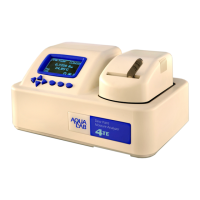17 APPENDIX C AquaLab
his own. The uncertainty he published is due to variation among the
results from the different methods. There are, therefore, limitations
to the accuracy of these values. The instrumentation available for
making water activity measurements is much better now than it was
in 1977, so improved standards are needed.
Saturated salt solutions can be prepared by several methods. The
AOAC method involves starting with salt and adding water in small
increments, stirring well with a spatula after each addition, until salt
can absorb no more water as evidenced by free liquid (where it will
take on the shape of the container but will not easily pour). This
method gives the most accurate readings, but only for a short time
unless great care is taken to prevent water gain or loss. When a salt
standard is prepared so that it consists mostly of liquid with a few
crystals in the bottom, it can result in a layer of less than saturated
solution at the surface which will produce a higher reading than an-
ticipated. Conversely, solid crystals protruding above the surface
of the liquid can lower the readings. To comply with Good Labo-
ratory Practices (GLP), a saturated salt solution must read within
reasonable analytical error of the accepted published value for a given
temperature.
Why AquaLab Verification Standards are Superior
Our research indicates that unsaturated salt solutions make much
better standards than saturated salts. Robinson and Stokes (1965)
give activity coefficient for various salt solutions. Customers can use
these activity coefficients to the water potential, or partial specific
Gibbs free energy, of the water in the solution using;
Ψ = −φγcRT (1)
where Ψ is the water potential, φ is the number of active particles
per molecule of solute (i.e. 2 for NaCl), γ is the activity coefficient,
c is the concentration of the solute (mol/kg
1
), R is the gas constant
(8.314 J mol/kg
−1
K
−1
), T is the Kelvin temperature. Water poten-
tial is related to water activity by the equation;
a
w
= exp
ΨM
w
RT
(2)
104

